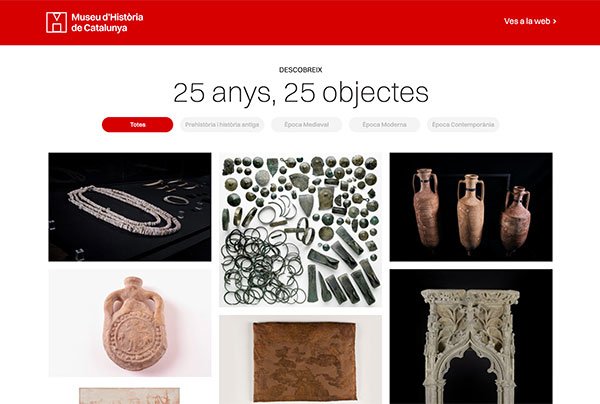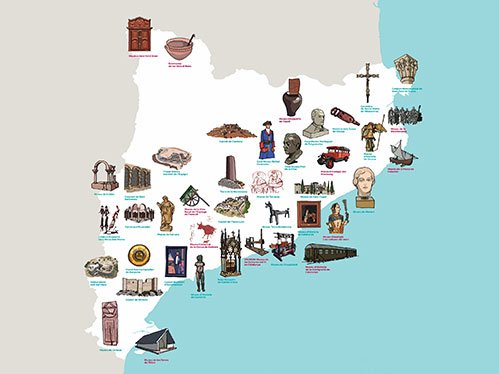Al canviar d'idioma no tots els continguts estan traduïts
The website is not fully translated
Al cambiar de idioma no todos los contenidos están traducidos
Al canviar d'idioma no tots els continguts estan traduïts
 Opening times
Opening times
 Location
Location
 Tickets
Tickets
 Admissions
Admissions
Opening times
Tuesday to Saturday, 10am to 7pm
Wednesdays, 10am to 8pm
Sundays and public holidays, 10am to 2.30pm
The ticket office and entrance are closed 30 minutes before closing time
CLOSED: Mondays that are not bank holidays, 1 and 6 January, 1 May, 18 May, 1 June, 25 and 26 December
Location
Address
Plaça de Pau Vila, 3
08039 Barcelona
Coordinates: 41.380900, 2.185693
Contact
932 254 700
mhc.cultura@gencat.cat
Fax 932 254 758
Group and school bookings:
932 254 244
Monday to Thursday: 10am-2pm and 3.30-5.30pm
Friday: 9.30am-2pm
mhcvisites.cultura@gencat.cat
Transport and access routes
Public transport
Buses V17, H14, D20, V15, V13, 39, 45, 51, 59 and 120
Metro L4 (yellow) Barceloneta
Train to Barcelona Estació de França
Barcelona Tourist Bus: red line; and Barcelona City Tour: eastern route; Museu d’Historia de Catalunya stop.
Parking
There are three paid-for car parks nearby: in Passeig Joan de Borbó, Moll d’Espanya and Moll de la Fusta.
Coaches have parking spaces available near the museum building.
“Bicing” bicycle hire in Plaça Pau Vila.
Admissions
Permanent exhibition
Temporary exhibitions
General admission: 4 euros
Reduced admission: 3 euros
Combined ticket
Permanent exhibition + temporary exhibition
General admission: 8 euros
Reduced admission: 6 euros
 Opening times
Opening times
 Location
Location
 Tickets
Tickets
 Admissions
Admissions
Opening times
Tuesday to Saturday, 10am to 7pm
Wednesdays, 10am to 8pm
Sundays and public holidays, 10am to 2.30pm
The ticket office and entrance are closed 30 minutes before closing time
CLOSED: Mondays that are not bank holidays, 1 and 6 January, 1 May, 18 May, 1 June, 25 and 26 December
Location
Address
Plaça de Pau Vila, 3
08039 Barcelona
Coordinates: 41.380900, 2.185693
Contact
932 254 700
mhc.cultura@gencat.cat
Fax 932 254 758
Group and school bookings:
932 254 244
Monday to Thursday: 10am-2pm and 3.30-5.30pm
Friday: 9.30am-2pm
mhcvisites.cultura@gencat.cat
Transport and access routes
Public transport
Buses V17, H14, D20, V15, V13, 39, 45, 51, 59 and 120
Metro L4 (yellow) Barceloneta
Train to Barcelona Estació de França
Barcelona Tourist Bus: red line; and Barcelona City Tour: eastern route; Museu d’Historia de Catalunya stop.
Parking
There are three paid-for car parks nearby: in Passeig Joan de Borbó, Moll d’Espanya and Moll de la Fusta.
Coaches have parking spaces available near the museum building.
“Bicing” bicycle hire in Plaça Pau Vila.
Admissions
Permanent exhibition
Temporary exhibitions
General admission: 4 euros
Reduced admission: 3 euros
Combined ticket
Permanent exhibition + temporary exhibition
General admission: 8 euros
Reduced admission: 6 euros
Awakening of political consciousness
In the mid-1960s, Antoni Tàpies entered a new phase of increasing involvement in the anti-Franco political movements in Catalonia. His participation in the Caputxinada led to his consciousness of the existence of a crosscutting active context for defending all those values in which he had always believed deeply: the defence of democracy, culture, peace and spirituality. Values that are found and propagated in the dimension of the Catalan spirit, which he always defended as the crystallisation of all his aspirations. Thus, until the death of the dictator, Tàpies participated in the main collective protest movements – Caputxinada, confinement of intellectuals in Montserrat, Congress of Catalan Culture – and he designed covers for albums and books by Catalan authors or various works that paid tribute to the country, such as Suite Catalana (Catalan Suite) (1972) or Als mestres de Catalunya (To the Teachers of Catalonia) (1974).

Caputxinada
Antoni Tàpies’ participation in the Caputxinada from 9 to 11 March 1966 marked a decisive moment in the development of his personal and artistic career. He took part alongside the filmmaker Pere Portabella, who helped to mobilise the country's intellectuals, such as Jordi Rubió, Maria Aurèlia Capmany, Pere Quart or Albert Ràfols-Casamada, supporting the inaugural meeting of the Democratic Syndicate of Students of the University of Barcelona (SDEUB) in the Capuchin convent of Sarrià. On the afternoon of 9 March, more than 450 people gathered for an event that was interrupted by security forces that surrounded the site. Under the auspices of the Capuchin community, many of the participants locked themselves in the convent, where debates and activities took place, the seeds of the Catalan nationalist, anti-Franco movement of the final years of the dictatorship. On 11 March, students and intellectuals, including Antoni Tàpies, were arrested and fined.
The Caputxinada drove Tàpies to commence writing his memoirs – A Personal Memoir: Fragments for an Autobiography – in which he observed the intensification of his activism for Catalan nationalism and progressive social movements.

Antoni Tàpies al convent dels Caputxins de Sarrià durant la Caputxinada. Barcelona, 9-11 de març de 1966. Arxiu Nacional de Catalunya. Autor: Guillem Martínez.
Pere Portabella and Antoni Tàpies
Pere Portabella (Figueres, 1927) played a pivotal role in the political awakening of Antoni Tàpies. A sculptor by profession, his friendship with the painter dated back to the time of the magazine Dau al Set and continued until the beginning of his career as a filmmaker, at the head of the production company Films59, becoming even closer when he returned from exile in Italy. Antoni Tàpies designed the main poster for his film No compteu amb els dits (Don't Count on Your Fingers) (1967), featuring a script by Joan Brossa and a soundtrack by Carlos Santos. Although the poster was originally in Catalan, censorship forced it to be translated into Spanish. The following year, Tàpies appeared as an actor in Nocturn 29 – the film’s title evoked the years of the dictatorship – alongside Lucia Bosé or Antonio Saura, with whom he shared a scene in the film, featuring a screenplay by Joan Brossa and music by Josep Maria Mestres Quadreny.
Confinement of intellectuals in Montserrat
On 12 December 1970, almost three hundred intellectuals locked themselves in the Montserrat monastery to protest against the Burgos trials, a war council that had sentenced six ETA militants to death for the murder of the head of the sociopolitical brigade in Gipuzkoa. The initiative was spearheaded by the Coordinating Commission of the Political Forces of Catalonia (CCFPC) and the Taula Rodona, or Round Table, whose spokesperson was Pere Portabella, the driving force behind the event. Antoni Tàpies joined the call along with other artists and cultural workers, such as Josep Guinovart, Oriol Bohigas, Jaime Camino, Eugenio Trias, Guillermina Motta, Alexandre Cirici and Joan Brossa, among others. The painter was given the task of bringing Joan Miró to the meeting, which coincided with the presentation of a mural he had made with Josep Royo for the Tarragona Red Cross.
Threatened by the forces of law and order, the participants locked themselves in Montserrat for three days, until 14 December, in order to discuss the current state of the country and its future. They also set up the Permanent Assembly of Catalan Intellectuals (APIC), which played a prominent role in the creation of the Assembly of Catalonia and the Congress of Catalan Culture.

Tancada a Montserrat. Barcelona, 1970 © Archivo Colita
Congress of Catalan Culture
Arising from the initiative of the Permanent Assembly of Catalan Intellectuals and the Barcelona Bar Association, the Congress of Catalan Culture (CCC) was a historic mobilisation of people that brought together various sectors of Catalan society between 1975 and 1977. Its main goals were to normalise the Catalan language and defend the basic rights of Catalans, including an analysis of twenty-five different areas, such as language, civil law, agriculture, industry, the plastic arts, science or territory. Each sector organised its own debates and presented its conclusions in various towns and cities in the Països Catalans, or Catalan Countries, mobilising more than twelve thousand citizens. Antoni Tàpies, together with Joan Miró and Josep Maria Subirachs, designed the general poster for the event, as well as the posters for other parallel events, such as the Catalan Youth Congress and the World Songs for a People festival, which took place at the Barcelona Football Club stadium, including the participation of Raimon, Lluís Llach and Leo Ferré.
Opening times
Tuesday to Saturday, 10am to 7pm
Wednesdays, 10am to 8pm
Sundays and public holidays, 10am to 2.30pm
The ticket office and entrance are closed 30 minutes before closing time
CLOSED: Mondays that are not bank holidays, 1 and 6 January, 1 May, 18 May, 1 June, 25 and 26 December
Location
Address
Plaça de Pau Vila, 3
08039 Barcelona
Coordinates: 41.380900, 2.185693
Contact
932 254 700
mhc.cultura@gencat.cat
Fax 932 254 758
Group and school bookings:
932 254 244
Monday to Thursday: 10am-2pm and 3.30-5.30pm
Friday: 9.30am-2pm
mhcvisites.cultura@gencat.cat
Transport and access routes
Public transport
Buses V17, H14, D20, V15, V13, 39, 45, 51, 59 and 120
Metro L4 (yellow) Barceloneta
Train to Barcelona Estació de França
Barcelona Tourist Bus: red line; and Barcelona City Tour: eastern route; Museu d’Historia de Catalunya stop.
Parking
There are three paid-for car parks nearby: in Passeig Joan de Borbó, Moll d’Espanya and Moll de la Fusta.
Coaches have parking spaces available near the museum building.
“Bicing” bicycle hire in Plaça Pau Vila.
Admissions
Permanent exhibition
Temporary exhibitions
General admission: 4 euros
Reduced admission: 3 euros
Combined ticket
Permanent exhibition + temporary exhibition
General admission: 8 euros
Reduced admission: 6 euros




 Twitter
Twitter Facebook
Facebook